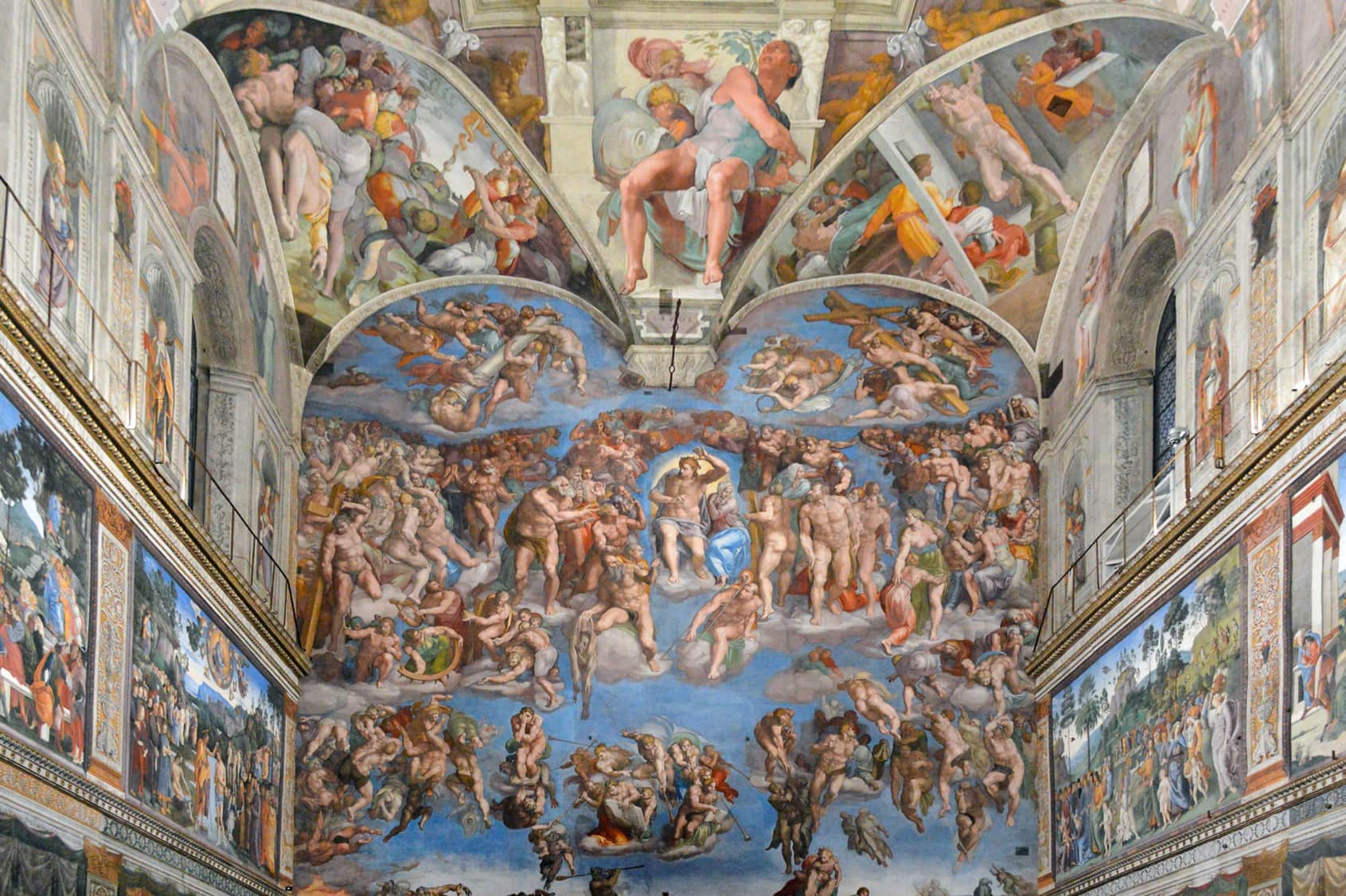
What makes Michelangelo's The Last Judgment a timeless masterpiece?
Michelangelo's The Last Judgment stands as a monumental fresco that continues to captivate audiences with its sheer scale and emotional intensity. Commissioned by Pope Clement VII in 1536 and completed in 1541, this artwork adorns the altar wall of the Sistine Chapel in Vatican City. Measuring approximately 39 feet by 45 feet, it features over 300 meticulously crafted figures, blending Christian and pagan themes. The fresco depicts the Second Coming of Christ and the final judgment of souls, showcasing Michelangelo's unique artistic vision. Despite controversies over its nudity and subsequent censorship, The Last Judgment remains a cultural icon, drawing over 25,000 viewers daily.
Key Takeaways:
- Michelangelo's "The Last Judgment" is a monumental fresco depicting the Second Coming of Christ and the final judgment of souls, blending Christian and pagan influences to create a visually stunning narrative.
- The artwork faced controversies and censorship due to its nudity, but it remains a timeless masterpiece that continues to captivate art lovers and scholars alike, showcasing Michelangelo's mastery and blending of different themes.
The Last Judgment: A Masterpiece by Michelangelo
Michelangelo's The Last Judgment is a monumental fresco that stands as one of the most iconic works of art in history. Commissioned by Pope Clement VII, this masterpiece adorns the altar wall of the Sistine Chapel in Vatican City. Let's dive into some fascinating facts about this incredible artwork.
-
Commission and Completion
The Last Judgment was commissioned by Pope Clement VII in 1536. Michelangelo, who had previously worked on the Sistine Chapel ceiling, began this new project and completed it in 1541. This fresco was a significant undertaking, measuring approximately 39 feet by 45 feet, making it one of the largest artworks of its time. -
Historical Context
The Last Judgment was created during a period of great turmoil in Rome. The Sack of Rome in 1527 had left the city in ruins, and the aftermath of this event had a profound impact on the city's recovery. This historical context is reflected in the somber and dramatic tone of the fresco. -
Subject Matter
The Last Judgment depicts the Second Coming of Christ and the final judgment of souls. It is a traditional subject in Christian art, symbolizing the end of the world and the ultimate reckoning of humanity. The fresco showcases over 300 figures, each meticulously crafted to convey intense emotion and drama.
Michelangelo's Unique Artistic Vision
Michelangelo's vision for The Last Judgment was innovative and unique. He blended Christian and pagan influences to create a visually stunning narrative.
-
Artistic Vision
Michelangelo's artistic vision for The Last Judgment was unique and innovative. He included figures from Greek mythology, such as Charon and Minos, alongside Christian figures like Jesus, Mary, and saints. This blend of mythological and biblical themes adds depth and complexity to the narrative. -
Mythological Figures
One of the most interesting aspects of The Last Judgment is the inclusion of mythological figures. Charon, who ferries souls to Hades, is depicted at the bottom of the fresco, while Minos, a judge in Hades according to Dante's Inferno, is shown as a serpent-wrapped figure. These inclusions reflect Michelangelo's use of pagan mythology to enhance the Christian narrative. -
Biagio de Cesena
A legend surrounding the fresco involves Biagio de Cesena, the Master of Ceremonies for the unveiling of Paul III. According to the legend, Michelangelo portrayed de Cesena as the mythological judge Minos with a serpent biting his genitals. Recent cleaning of the fresco has revealed this serpent, adding to the narrative's intrigue.
Controversies and Censorship
The Last Judgment faced its share of controversies, particularly regarding the nudity of its figures. This led to significant changes in the artwork.
-
Nudity and Censorship
The Last Judgment originally featured many nude figures, which caused controversy. The Council of Trent, just a few weeks before Michelangelo's death, commissioned artist Daniele da Volterra to add clothing to the nude figures. This censorship reflects the changing attitudes towards nudity in art during the Renaissance. -
Self-Portrait
Art historians believe that Michelangelo included his own self-portrait in the fresco. The skin held by St. Bartholomew, who was flayed alive for his faith, is thought to have Michelangelo's face. This self-portrait adds a personal touch to the artwork, highlighting Michelangelo's involvement in the project.
Scale, Impact, and Historical Precedents
The Last Judgment is not only massive in scale but also in its impact on art and culture. It stands apart from earlier interpretations of the final judgment.
-
Scale and Impact
The Last Judgment is massive, measuring approximately 39 feet by 45 feet. In comparison, Leonardo da Vinci's The Last Supper fresco is significantly smaller, measuring about 15 feet by 29 feet. The sheer scale of The Last Judgment makes it a dominant feature in the Sistine Chapel, drawing over 25,000 viewers daily. -
Historical Precedents
The Last Judgment is not the first artwork to depict the final judgment. Earlier Renaissance artists, such as Signorelli, had also explored this theme. Michelangelo's work, however, is unique in its blend of Christian and pagan elements, setting it apart from earlier interpretations. -
Biblical Departures
Michelangelo took artistic license with the biblical story in The Last Judgment. He depicted a beardless Christ and omitted Christ's throne and heavenly host. These deviations from the traditional narrative are documented in Giovanni Andrea Gillio's book "Due Dialogi," which collects all Michelangelo's departures from the biblical tradition.
Covering Previous Works and Symbolism
Creating The Last Judgment required covering previous artworks and incorporating rich symbolism.
-
Covering Previous Works
To make way for The Last Judgment, existing artworks had to be demolished. These included "The Assumption of Mary" by Pietro Perugino and two of Michelangelo's own earlier works, the "Ancestors of Christ" lunettes. Portions of Perugino's Moses and "Adoration of the Kings" cycles were also covered by the fresco. -
Seven Deadly Sins
One school of thought suggests that the descending figures in The Last Judgment correspond to the seven deadly sins. For example, one tumbling figure carries keys and coins, representing greed. This interpretation adds another layer of meaning to the artwork, highlighting the moral themes present in the narrative. -
Golden Aura
The golden aura surrounding Christ and Mary at the center of the fresco may be a reference to Apollo, the Greek god of the sun. Christ's rotating arms suggest the circular motion of the heavens as well as the cycle of life, death, and resurrection. This use of pagan mythology to enhance Christian themes is characteristic of Michelangelo's artistic vision.
Emotional Intensity and Aging
The Last Judgment is known for its emotional intensity and has undergone changes over time due to natural aging.
-
Emotional Intensity
Each figure in The Last Judgment is meticulously crafted to convey intense emotion and drama. The dead rising from their graves still preserve the colors of the earth—dun, ocher, drab—while a few patches of red appear in the angels' cloaks. The dominant color is human flesh against the slaty blue sky, creating a somber and haunting atmosphere. -
Darkening Over Time
The whole section of The Last Judgment has darkened considerably from the smoke of the candles at the altar. This natural aging process adds to the overall somber tone of the fresco, reflecting the historical context in which it was created.
Symbolism, Themes, and Michelangelo’s Age
The Last Judgment is filled with rich symbolism and themes, reflecting Michelangelo's age and experience.
-
Symbolism and Themes
The Last Judgment is filled with historical details as well as Christian, Greco-Roman mythological, and personal narratives. The space directly above the altar is reserved for the mouth of Hell, into which the celebrant of the Mass frequently could look as he performed the sacred ritual. This symbolism underscores the themes of judgment and redemption present in the artwork. -
Michelangelo’s Age
When Michelangelo completed The Last Judgment at the age of 67, he was already an experienced artist. His inclusion of his own self-portrait and the depiction of St. Bartholomew add a personal touch to the artwork, reflecting his advanced age and experience.
Impact on Art and Cultural Significance
The Last Judgment has had a profound impact on art and culture, showcasing Michelangelo's mastery and blending of different themes.
-
Impact on Art
The Last Judgment has had a profound impact on art throughout history. It showcases Michelangelo’s mastery of fresco painting and his ability to blend different artistic styles and themes. The fresco’s massive scale and emotional intensity have influenced countless artists, making it a cornerstone of Renaissance art. -
Cultural Significance
The Last Judgment is not just an artwork; it is a cultural icon. It represents the culmination of Renaissance art and the blending of Christian and pagan influences. The fresco’s cultural significance extends beyond its historical context, making it a timeless masterpiece that continues to captivate art lovers and scholars alike.
Timeless Masterpiece
Michelangelo's Last Judgment stands as a testament to his artistic genius and the rich tapestry of Renaissance art. Created during a turbulent time in Rome, this fresco blends Christian and pagan elements, showcasing over 300 meticulously crafted figures. The inclusion of mythological characters like Charon and Minos adds depth, while the intense emotions of each figure draw viewers into the narrative. Despite controversies over nudity and subsequent censorship, the fresco's impact on art history remains profound. Michelangelo's self-portrait and the darkening over time add personal and historical layers to the piece. The Last Judgment continues to captivate millions, reflecting themes of judgment, redemption, and the human condition. Its massive scale and intricate symbolism make it a cultural icon, ensuring Michelangelo's legacy endures through the ages. This masterpiece isn't just art; it's a window into the soul of the Renaissance.
Frequently Asked Questions
Was this page helpful?
Our commitment to delivering trustworthy and engaging content is at the heart of what we do. Each fact on our site is contributed by real users like you, bringing a wealth of diverse insights and information. To ensure the highest standards of accuracy and reliability, our dedicated editors meticulously review each submission. This process guarantees that the facts we share are not only fascinating but also credible. Trust in our commitment to quality and authenticity as you explore and learn with us.


